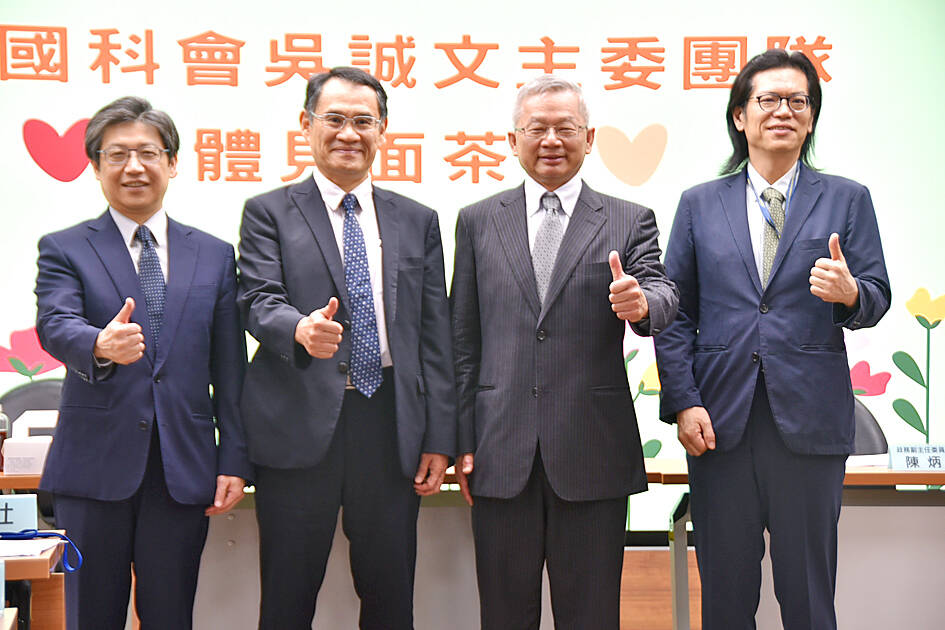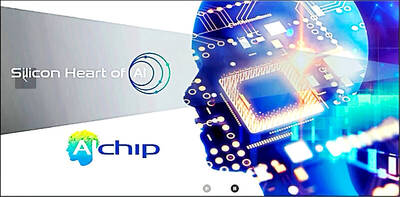The National Science and Technology Council (NSTC) yesterday said it plans to present new projects within three months that would facilitate the development of power devices used in electric vehicles (EVs) and energy converters to complete the missing piece in the nation’s semiconductor industry.
Aside from the 2-nanometer or 1.4-nanometer semiconductor process technologies, Taiwan also seeks to broaden its semiconductor coverage to include power devices, or power semiconductors, which are made using less advanced technologies, NSTC Minister Wu Cheng-wen (吳誠文) told his first news conference in office yesterday.
Power devices are a key component of energy converters used in smart grids and metal oxide semiconductor field effect transistors for EVs, the NSTC said.

Photo: Wu Po-hsuan, Taipei Times
The agency aims to build an extensive smart grid hardware supply chain that covers everything from semiconductor modules to systems, Wu said.
“Taiwan has not made a full effort to develop this segment. This is the missing piece in the nation’s semiconductor industry,” Wu said. “We are aiming to build our own supply of power devices to facilitate the development of smart grids and smart EVs.”
Wu said that his task is to fulfill President William Lai ’s (賴清德) goal of having a “balanced” industrial environment.
As Taiwan has built a robust technology industry, it should leverage the power of technologies such as artificial intelligence to facilitate the development of the traditional sector and “green” energy, among others, he said.
Less advanced 8-inch fabs can be used to produce power devices on mature technology nodes such as 25-nanometer and 65-nanometer technologies, NSTC Deputy Minister Lin Faa-jeng (林法正) said on the sidelines of the news conference.
“There is no need for all companies to develop advanced technologies,” Lin said.
As Taiwan is to usher in an energy environment abound with renewable energy systems, EV charging piles and power storage units, energy converters would be critical to connect solar or other sources of renewable energy to Taiwan Power Co’s (台電) grids, he said.
Power devices are the key component for energy converters, he added.
The NSTC would push for Taiwan to produce the silicon carbide and gallium nitride used to make power devices, Lin said.
Local power device makers are facing difficulties finding the optimal materials and improving their yield rate, resulting in high manufacturing costs, Lin said.
The NSTC plans to offer funding to local universities and colleges to work together with local semiconductor companies to improve power device manufacturing capabilities, Lin said, adding that detailed plans would be unveiled in three months.
In addition to power devices, the NSTC is seeking to collaborate with the Ministry of Economic Affairs to build “science parks” overseas with the assistance of friendly allies, helping smaller businesses to expand their manufacturing footprints globally, Wu said.
That would help mitigate a talent shortage and tight supply of power, he said.
Asked about Taiwan Semiconductor Manufacturing Co’s (TSMC, 台積電) plan to make advanced 2-nanometer chips in the US, Wu said the chip giant has promised to maintain a research-and-development center and its most advanced technologies at home.
TSMC now operates a 2-nanometer R&D center in Hsinchu and plans to ramp up production of 2-nanomter chips there as well as other sites in Taiwan, Wu said.
He said he believes TSMC has the ability to safeguard its corporate secrets and technological know-how.

To many, Tatu City on the outskirts of Nairobi looks like a success. The first city entirely built by a private company to be operational in east Africa, with about 25,000 people living and working there, it accounts for about two-thirds of all foreign investment in Kenya. Its low-tax status has attracted more than 100 businesses including Heineken, coffee brand Dormans, and the biggest call-center and cold-chain transport firms in the region. However, to some local politicians, Tatu City has looked more like a target for extortion. A parade of governors have demanded land worth millions of dollars in exchange

An Indonesian animated movie is smashing regional box office records and could be set for wider success as it prepares to open beyond the Southeast Asian archipelago’s silver screens. Jumbo — a film based on the adventures of main character, Don, a large orphaned Indonesian boy facing bullying at school — last month became the highest-grossing Southeast Asian animated film, raking in more than US$8 million. Released at the end of March to coincide with the Eid holidays after the Islamic fasting month of Ramadan, the movie has hit 8 million ticket sales, the third-highest in Indonesian cinema history, Film

Taiwan Semiconductor Manufacturing Co’s (TSMC, 台積電) revenue jumped 48 percent last month, underscoring how electronics firms scrambled to acquire essential components before global tariffs took effect. The main chipmaker for Apple Inc and Nvidia Corp reported monthly sales of NT$349.6 billion (US$11.6 billion). That compares with the average analysts’ estimate for a 38 percent rise in second-quarter revenue. US President Donald Trump’s trade war is prompting economists to retool GDP forecasts worldwide, casting doubt over the outlook for everything from iPhone demand to computing and datacenter construction. However, TSMC — a barometer for global tech spending given its central role in the

Alchip Technologies Ltd (世芯), an application-specific integrated circuit (ASIC) designer specializing in server chips, expects revenue to decline this year due to sagging demand for 5-nanometer artificial intelligence (AI) chips from a North America-based major customer, a company executive said yesterday. That would be the first contraction in revenue for Alchip as it has been enjoying strong revenue growth over the past few years, benefiting from cloud-service providers’ moves to reduce dependence on Nvidia Corp’s expensive AI chips by building their own AI accelerator by outsourcing chip design. The 5-nanometer chip was supposed to be a new growth engine as the lifecycle